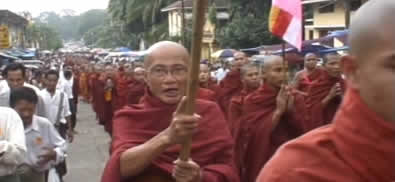 In September 2007, more than 100,000 Burmese citizens – including thousands of Buddhist monks – took to the streets of Rangoon to protest the repressive regime that has held them hostage for more than 40 years. Although foreign news crews were banned from entering the country and the Internet was shut down, the Democratic Voice of Burma (DVB), a collective of anonymous and underground video journalists (VJs), recorded these historic events on handycams at great risk to themselves and smuggled the footage out of the country, to be broadcast worldwide via satellite.
In September 2007, more than 100,000 Burmese citizens – including thousands of Buddhist monks – took to the streets of Rangoon to protest the repressive regime that has held them hostage for more than 40 years. Although foreign news crews were banned from entering the country and the Internet was shut down, the Democratic Voice of Burma (DVB), a collective of anonymous and underground video journalists (VJs), recorded these historic events on handycams at great risk to themselves and smuggled the footage out of the country, to be broadcast worldwide via satellite.
Anders Østergaard’s documentary BURMA VJ: REPORTING FROM A CLOSED COUNTRY takes a rare inside look at Burma’s 2007 uprising through the cameras of these independent journalists when it debuts TUESDAY, APRIL 20 (9:30-11:00 p.m. ET/PT), exclusively on HBO. The film received an Oscar nomination for Best Documentary Feature this year.
Other HBO play dates: April 24 (3:15 p.m.), 27 (1:00 p.m.) and 30 (4:00 p.m.), and May 2 (11:00 a.m., 5:25 a.m.), 6 (10:00 a.m.) and 12 (12:30 a.m.)
HBO2 play dates: April 28 (8:00 p.m.) and May 8 (noon) and 18 (noon)
BURMA VJ sheds light on a brutal 40-year military regime operating in a closed country, far from the eyes of the mainstream global media. Although there was a brief uprising in 1988, the military junta soon retook power, violently suppressing any opposition to the reigning regime. Aung San Suu Kyi, an elected official and hero of the people, has been under house arrest ever since.
regime. Aung San Suu Kyi, an elected official and hero of the people, has been under house arrest ever since.
In August 2007, economic desperation, coupled with the junta’s decision to lift fuel subsidies, triggered the peaceful uprising that would come to be known as the “Saffron Revolution,” after the color of the monks’ robes. BURMA VJ documents the dramatic days of the September 2007 revolution, when nonviolent protests gave way to military brutality, as Buddhist monks, students and ordinary citizens were inspired to march, and in some cases die, for the rights they have been denied for so long.
Risking torture, life in jail and even death, the young members of the Democratic Voice of Burma kept up the flow of news from their closed, military-controlled country. BURMA VJ focuses on “Joshua,” one of the young video journalists of the DVB who worked undercover to counter government propaganda. His intrepid and resilient reporting revealed the growing tension in the months and weeks before the September 2007 uprising. (For obvious reasons, Østergaard cannot disclose the real identity of Joshua or any of the other activists who supplied material for broadcast.)
Joshua coordinated the VJs’ efforts from Thailand, becoming an essential liaison to the reporters on the ground when the monks suddenly led a massive but peaceful uprising against the military regime. As Burma returned to the world stage after decades of obscurity, it was left to Joshua and his fellow journalists to document the events and bear witness to the world. Smuggled out of the country by Internet upload or through couriers, their footage was sent to Oslo, Norway, where it was broadcast back into Burma via satellite to counter the regime’s misinformation.
The uprising reached its pinnacle when the army fired into the crowd and killed a Japanese journalist point blank. The VJs captured the shooting on camera. The monks all disappeared, likely taken by the police, and only students were left to demonstrate. The body of a monk was found floating in a creek. Rangoon became a war zone. The Internet was entirely shut down by the government, making it harder to get images out.
By December 2007, the government had succeeded in shutting down the DVB and arrested three reporters. Other journalists went into hiding, and Joshua had to rebuild the entire network. Today, everything is back to “normal,” with the junta’s propaganda machine ruling the media in Burma. However, on the ruins of the original network, Joshua and the Democratic Voice of Burma have recruited new VJs who were inspired by the events of September 2007. They are now undergoing camera and safety training, getting ready for the next popular uprising in Burma, as the media battle against the junta continues.
In addition to receiving an Oscar® nomination, BURMA VJ won the Grand Jury Prize at the 2009 Full Frame Documentary Festival, the International Human Rights Film Award at the 2009 Berlin Film Festival and an award for World Cinema Documentary Film Editing at the 2009 Sundance Film Festival.
Anders Østergaard was born in Copenhagen and graduated from the Danish School of Journalism in 1991. After five years in advertising and public relations, he wrote and directed his first documentary, “Johannesburg Revisited,” followed by 2004’s “Tintin and Me” and 2006’s “Gasolin’,” which became the highest-grossing documentary in the history of Danish cinema. Both “Tintin and Me” and “Gasolin’” won the Bodil Award, Denmark’s highest film honor, for the best documentary film of the year.
BURMA VJ: REPORTING FROM A CLOSED COUNTRY is directed by Anders Østergaard; producer, Lise Lense Moller; editor, Janus Billeskov Jansen; assistant director and additional photography, Jan Krogsgaard; co-producer on location, Sam Kalayanee and Images of Asia; editing consultant, Anders Villadsen; produced by Magic Hour Films; co-produced by WG Films, Mediamente, Kamoli Films, The Danish Film Institute and DR TV. For HBO: supervising producer, Sara Bernstein; executive producer, Sheila Nevins.
For more info please check the HBO site.
http://www.hbo.com/#/documentaries/burma-vj-reporting-from-a-closed-country/index.html

